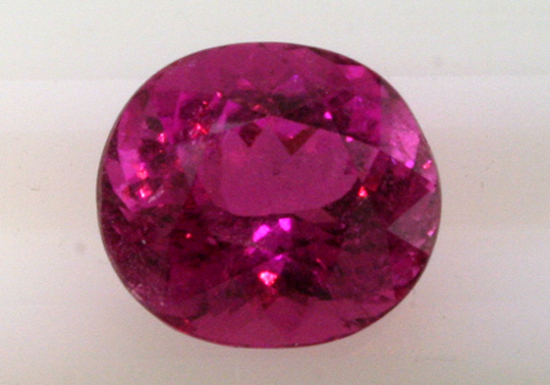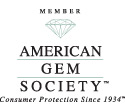The Perils of Paraiba-Jewelers Tears #2
September 23rd, 2010 by James L. Sweaney, CGA, FGA. GG
8.65 ct. cuprian elbaite tourmaline, before heat treatment
This tale of woe illustrates some of the risks and challenges we jewelers face in our fascinating business.
Last year, I had seen this lovely and large reddish purple tourmaline several times. Gem dealer Jack had tried mightily to tempt me with it, an unheated stone from the country of Mozambique in East Africa, an area that is producing controversial vivid blue and green tourmaline gems.
The controversy arises from new finds of tourmalines in both Mozambique and Nigeria that are very much like the famous and hugely expensive “Paraiba” tourmalines mined in and around the Paraiba state in Brazil. Discovered in the late 1980's, the Paraiba gems “electrified” the gem world with their previously unseen exotic colors, only to be followed by discoveries of similar material in Nigeria in 2001 and Mozambique in 2004. Like the original Paraiban material, some of these African tourmalines turn to vivid blues and greens when carefully heat treated.
The best of these rare colors have been described as “neon” and “electric”, with some top echelon gems fetching five figures per carat. This museum quality 10 carat stone (the picture certainly doesn't do it justice) was offered by a friend of the author last year for just under $200,000!

The controversy within the gem trade is one of nomenclature–whether the bright blue and green material from Mozambique and Nigeria can properly be designated and marketed as “Paraiba” tourmaline. Various gem labs and ruling bodies have taken up the question, conferences have been held, blogs and insults have flown back and forth, with no clear resolution. While the purists say that only gems mined in or near the Brazilian state of Paraiba can truly be labeled as “Paraiba” tourmaline, owners of the African gems often sell them as “Paraiba” tourmaline.
As we have seen with Burma ruby, Kashmir sapphire, and Colombian emerald, the power of name association creates a very strong brand that can be an extremely powerful marketing tool. It's especially useful when introducing a heretofore unknown product such as this type of tourmaline. Just google “paraiba tourmaline” and you'll see more than 35,000 results, many from mass market merchandisers like Home Shopping Network, Jewelry TV, and Ebay, selling everything from fine “Paraiba” gems for tens of thousands of dollars to “bargain” stones priced at tens of dollars.
One of the real problems is how to distinguish the Brazilian “Paraiba” gems from the African “Paraiba-like” stones. Color is not a reliable standard because there is so much natural variation in the desired hues, nor is size is a reliable test. Although stones mined in Brazil are usually smaller than the African goods, with few gems exceeding 3 carats, some Brazilian stones are good sized, witness the 10 ct. gem shown above.
These elbaite varieties of tourmaline are all characterized by traces of copper in their chemistry which can be reliably detected by spectroscopic analysis. Some of the gem labs have been designating type but not country of origin.
Tags: AGS, AGTA, Cuprian Elbaite Tourmaline, GemGuide, GIA, LMHC, Mozambique, Nigeria, Paraiba







